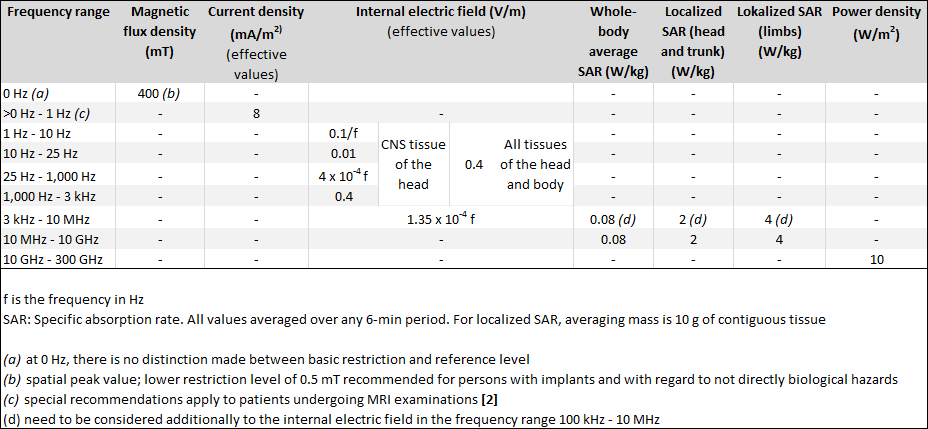Basic restrictions
Basic restrictions are limits for personal protection, which specify the maximum exposure allowed in the whole body or in parts of the body with respect to the emissions from field-generating devices and systems. This type of limit includes safety factors and serves as a basis for limiting personal exposure. The basic restrictions are based on proven biological effects. Compliance with the basic restrictions can be validated only in part by direct measurements.
Depending on frequency, the following physical quantities are used to specify the basic restrictions on electric, magnetic, and electromagnetic fields, (ICNIRP: [1], [2], [3], [4] see also table “Basic restrictions”):
- 0 Hz (static fields) to 1 Hz:
Magnetic flux density (T), Current density (A/m2)
Protection goal: to avoid effects on the cardiovascular and nervous system - 1 Hz to 10 MHz:
Current density (A/m2), Internal electric field (V/m), SAR (W/kg)
Protection goals: to avoid effects on nervous system functions, whole-body heat stress, and excessive localized heating of tissues - 10 MHz to 10 GHz:
SAR (W/kg)
Protection goals: to avoid whole-body heat stress and excessive localized heating of tissues - 10 GHz to 300 GHz:
Power density (W/m2)
Protection goal: to avoid heating in tissue at or near the body surface
Of these quantities, the magnetic flux density and the power density can be measured directly at the exposed human body.

Additionally, for pulsed exposures in the frequency range 0.3 to 10 GHz and for localized exposure of the head, in order to limit or avoid auditory effects caused by thermoelastic expansion (cf. Microwave hearing), an additional basic restriction is recommended. This is that the Specific Absorption (SA) should not exceed 10 mJ/kg for workers and 2 mJ/kg for the general public, averaged over 10 g tissue (ICNIRP, p. 509, see note 7 in table 4).